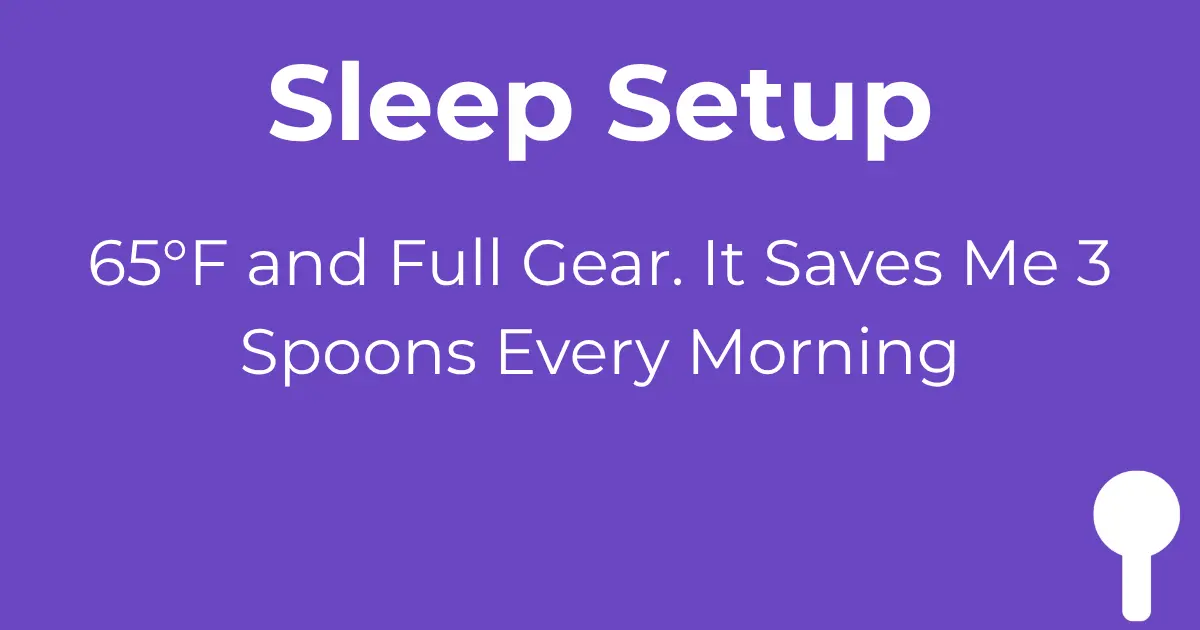
My Sleep Setup Isn't Excessive. It Saves Me 3+ Spoons Every Morning.
65°F. Sleep mask. White noise machine. Weighted blanket. Earbuds. Fan. 30-minute wind-down with familiar audio.
My family says I'm doing "too much" just to go to sleep.
They don't realize I'm accommodating for the sensory overload my environment causes: loud warehouse noises at work, uncomfortable sensations on my skin when I run. This drains my spoons and extends the amount of sleep I need to feel better the next day.
Research directly confirms what I experience: Sleep disturbances are common in autistic adults due to sensory sensitivities and difficulty with environmental regulation.
What Happens Without My Setup
My spoons are much lower. My tolerance for things that bring me sensory discomfort—loud noises, sudden slamming—is much lower too.
High temperatures make falling asleep exhausting and stressful.
Without my full setup, I need an additional 30 minutes of sleep the following night just to compensate.
Poor sleep quality compounds my autistic burnout When I don't get proper rest, my baseline spoons the next day are lower, which means I'm one step closer to complete shutdown.
Why 65°F Specifically
70°F is too high. My blanket is thick and heavy. The material resting on my skin increases my body temperature.
65°F is my middle ground, especially if my room is already cold.
If my room is already hot, I'll switch to 60°F temporarily for that one night.
My Full Setup
Sleep mask: Blocks out light while I'm trying to sleep.
White noise machine: Blocks loud conversations happening outside my room.
Weighted blanket: Reduces micro-movements during sleep.
Pillow: Neck comfort.
Fan: Counters unpredictable temperature in my room (no AC installed—family won't do it).
Earbuds + familiar audio: Rain sounds, walking tour audio. Screens are stimulating and exhausting, so I keep them away from my bed and place them on my table to not disturb my sleep.
30-minute wind-down before bed: Calms my mind down before I drift into sleep.
"You're Doing Too Much"
My family says this constantly.
Typical neurotypical advice.
They don't understand that my environment is hostile. Work destroys me. Running drains me. Sleep has to compensate for all of it.
Without my setup, I need 8.5 hours instead of 8. That's 30 minutes I don't have.
What Tracking Showed Me
Days I don't have sensory protection—earplugs, light-sensitivity glasses—the subtle drains add up by the end of the day.
I realized I need an additional 30 minutes to an hour of sleep some days due to constant sensory overload.
Tracking helped me minimize the sensory load I experience on a daily basis. I made adjustments to my sleep routine. I wear Theraspecs when I go outside.
Small changes. Massive spoon savings.
The Reality
My sleep setup isn't excessive. It's accommodation for a world that wasn't built for me.
Neurotypicals don't need 65°F and white noise because their environments aren't hostile to them. My setup compensates for sensory sensitivities that make 'normal' sleep conditions impossible for me.
65°F + full setup = 8 hours of sleep, functional the next day.
No setup = 8.5+ hours, still exhausted, lower tolerance.
I'm Omari, a 23-year-old autistic adult who's been managing chronic burnout for 5+ years while working warehouse shifts.
This is why I built Spoons. To see when sleep quality affects my baseline. To know when I need adjustments before burnout compounds.
Launching April 2026. getspoons.app - One email when it's ready. No spam.
— Omari
Note: I'm sharing my personal experience as an autistic adult, not medical advice. If you're experiencing severe burnout or crisis, please consult a healthcare provider familiar with autism.
